-
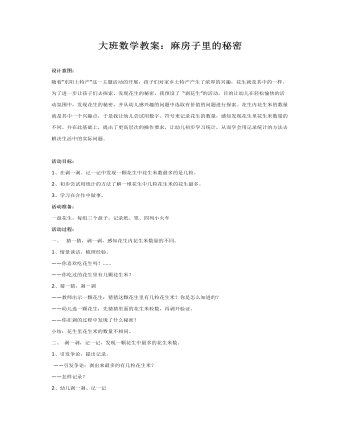
大班数学教案:麻房子里的秘密
活动目标:1、在剥一剥、记一记中发现一颗花生中花生米数最多的是几粒。2、初步尝试用统计的方法了解一堆花生中几粒花生米的花生最多。3、学习在合作中做事。活动准备:一盘花生,每组三个盘子,记录纸、笔、四列小火车活动过程:一、 猜一猜,剥一剥,感知花生内花生米数量的不同。1、情景谈话,梳理经验。——你喜欢吃花生吗?……——你吃过的花生里有几颗花生米?2、猜一猜,剥一剥——教师出示一颗花生:猜猜这颗花生里有几粒花生米?你是怎么知道的?——幼儿选一颗花生,先猜猜里面的花生米粒数,再剥开验证。——你在剥的过程中发现了什么秘密?小结:花生里花生米的数量不相同。
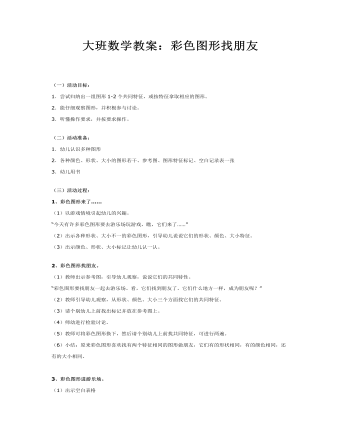
大班数学教案:彩色图形找朋友
2.能仔细观察图形,并积极参与讨论。 3.听懂操作要求,并按要求操作。 (二)活动准备: 1.幼儿认识多种图形 2.各种颜色、形状、大小的图形若干、参考图、图形特征标记、空白记录表一张 3.幼儿用书(三)活动过程: 1、彩色图形来了…… (1)以游戏情境引起幼儿的兴趣。 “今天有许多彩色图形要去游乐场玩游戏,瞧,它们来了……” (2)出示各种形状、大小不一的彩色图形,引导幼儿说说它们的形状、颜色、大小特征。 (3)出示颜色、形状、大小标记让幼儿认一认。
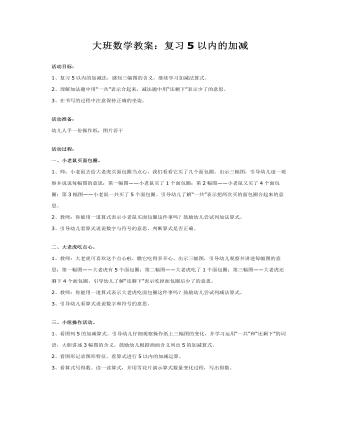
大班数学教案:复习5以内的加减
活动准备: 幼儿人手一份操作纸,图片若干 活动过程: 一、小老鼠买面包圈。 1、师:小老鼠去给大老虎买面包圈当点心,我们看看它买了几个面包圈。出示三幅图,引导幼儿逐一观察并说说每幅图的意思:第一幅图——小老鼠买了1个面包圈;第2幅图——小老鼠又买了4个面包圈;第3幅图——小老鼠一共买了5个面包圈。引导幼儿了解“一共”表示把两次买的面包圈合起来的意思。 2、教师:你能用一道算式表示小老鼠买面包圈这件事吗?鼓励幼儿尝试列加法算式。 3、引导幼儿看算式说说数字与符号的意思,判断算式是否正确。 二、大老虎吃点心。 1、教师:大老虎可喜欢这个点心啦,瞧它吃得多开心。出示三幅图,引导幼儿观察并讲述每幅图的意思:第一幅图——大老虎有5个面包圈;第二幅图——大老虎吃了1个面包圈;第三幅图——大老虎还剩下4个面包圈。引导幼儿了解“还剩下”表示吃掉面包圈后少了的意思。 2、教师:你能用一道算式表示大老虎吃面包圈这件事吗?鼓励幼儿尝试列减法算式。 3、引导幼儿看算式说说数字和符号的意思。
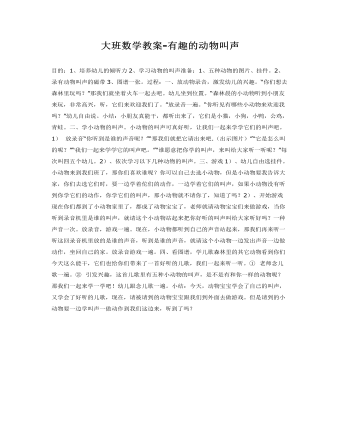
大班数学教案-有趣的动物叫声
1、培养幼儿的倾听力2、学习动物的叫声准备:1、五种动物的图片、挂件。2、录有动物叫声的磁带3、图谱一张。过程:一、放动物录音,激发幼儿的兴趣。“你们想去森林里玩吗?”那我们就坐着火车一起去吧。幼儿坐到位置。“森林晨的小动物听到小朋友来玩,非常高兴,听,它们来欢迎我们了。”放录音一遍。“你听见有哪些小动物来欢迎我吗?”幼儿自由说。小结:小朋友真能干,都听出来了,它们是小猫,小狗,小鸭,公鸡,青蛙。二、学小动物的叫声。小动物的叫声可真好听,让我们一起来学学它们的叫声吧。1) 放录音“你听到是谁的声音呢?”“那我们就把它请出来吧.(出示图片)”“它是怎么叫的呢?”“我们一起来学学它的叫声吧。”“谁愿意把你学的叫声,来叫给大家听一听呢?”每次叫四五个幼儿。2)、依次学习以下几种动物的叫声。三、游戏1)、幼儿自由选挂件。小动物来到我们班了,那你们喜欢谁呢?你可以自己去选小动物,但是小动物要我告诉大家,你们去选它们时,要一边学着佗们的动作,一边学着它们的叫声,如果小动物没有听到你学它们的动作,你学它们的叫声,那小动物就不请你了,知道了吗?
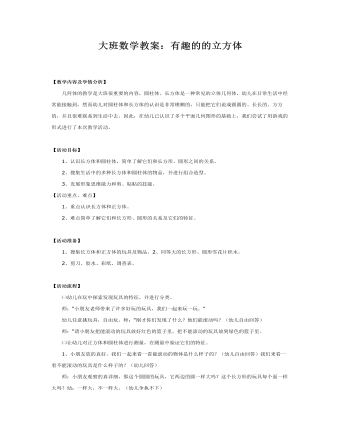
大班数学教案:有趣的的立方体
【活动目标】1、认识长方体和圆柱体,简单了解它们和长方形、圆形之间的关系。2、搜集生活中的多种长方体和圆柱体的物品,并进行组合造型。3、发展形象思维能力和剪、粘贴的技能。【活动重点、难点】 1、重点认识长方体和正方体。2、难点简单了解它们和长方形、圆形的关系及它们的特征。 【活动准备】1、搜集长方体和正方体的玩具及物品。2、同等大的长方形、圆形雪花片积木。2、剪刀、胶水、彩纸、调查表。 【活动流程】 ㈠幼儿在玩中探索发现玩具的特征,并进行分类。 师:“小朋友老师带来了许多好玩的玩具,我们一起来玩一玩。” 幼儿任意挑玩具,自由玩。师:“刚才你们发现了什么?他们能滚动吗?(幼儿自由回答) 师:“请小朋友把能滚动的玩具放好红色的篮子里,把不能滚动的玩具放到绿色的篮子里。 ㈡让幼儿对正方体和圆柱体进行测量,在测量中验证它们的特征。1、小朋友放的真好,我们一起来看一看能滚动的物体是什么样子的?(幼儿自由回答)我们来看一看不能滚动的玩具是什么样子的?(幼儿回答) 师:小朋友观察的真详细,那这个圆圆的玩具,它两边的圆一样大吗?这个长方形的玩具每个面一样大吗?幼:一样大,不一样大。(幼儿争执不下)2、老师出示纸条,幼儿亲自动手测量,不断验证自己的想法,最好得出结论。3、教师小结:这种身体像柱子一样,而且上下中间一样粗,两头都是一样大的圆形的物体,我们称它为圆柱体,圆柱体放倒了只能朝一个方向滚动。这种身体像盒子一样,有六个面,十二条边,一种每个面都是长方形,一种四个面是长方形的,另外两个面是正方形的物体,我们称它为长方体。
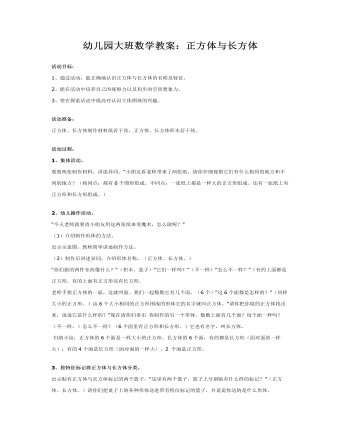
大班数学教案:正方体与长方体
2、能在活动中培养自己的观察力以及初步的空间想象力。 3、使在探索活动中提高对认识立体图体的兴趣。 活动准备: 正方体、长方体制作材料纸若干张,正方体、长方体积木若干块。 活动过程: 1、集体活动。 观察两张制作材料,讲述异同。“小朋友看老师带来了两张纸,请你仔细观察它们有什么相同的地方和不同的地方?(相同点:都有6个图形组成。不同点:一张纸上都是一样大的正方形组成。还有一张纸上有正方形和长方形组成。) 2、幼儿操作活动。 “今天老师就要请小朋友用这两张纸来变魔术,怎么做呢?” (1)介绍制作形体的方法。 出示示意图,教师简单讲述制作方法。
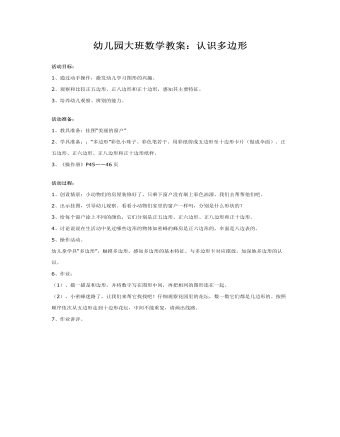
幼儿园大班数学教案:认识多边形
2、观察和比较正五边形、正八边形和正十边形,感知其主要特征。 3、培养幼儿观察、辨别的能力。 活动准备: 1、教具准备:挂图“美丽的窗户” 2、学具准备::“多边形”彩色小珠子、彩色笔若干。用彩纸剪成五边形至十边形卡片(做成伞面)。正五边形、正六边形、正八边形和正十边形纸样。 3、《操作册》P45——46页 活动过程: 1、创设情景:小动物们的房屋装修好了,只乘下窗户没有刷上彩色油漆,我们去帮帮他们吧。 2、出示挂图,引导幼儿观察。看看小动物们家里的窗户一样吗,分别是什么形状的?
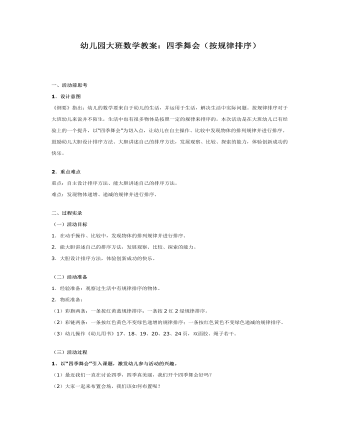
幼儿园大班数学教案:四季舞会
2.重点难点 重点:自主设计排序方法、能大胆讲述自己的排序方法。 难点:发现物体递增、递减的规律并进行排序。 二、过程实录 (一)活动目标 1.在动手操作、比较中,发现物体的排列规律并进行排序。 2.能大胆讲述自己的排序方法,发展观察、比较、探索的能力。 3.大胆设计排序方法,体验创新成功的快乐。 (二)活动准备 1.经验准备:观察过生活中有规律排序的物体。 2.物质准备: (1)彩旗两条:一条按红黄蓝规律排序;一条按2红2绿规律排序。 (2)彩链两条:一条按红色黄色不变绿色递增的规律排序;一条按红色黄色不变绿色递减的规律排序。 (3)幼儿操作《幼儿用书》17、18、19、20、23、24页,双面胶、绳子若干。
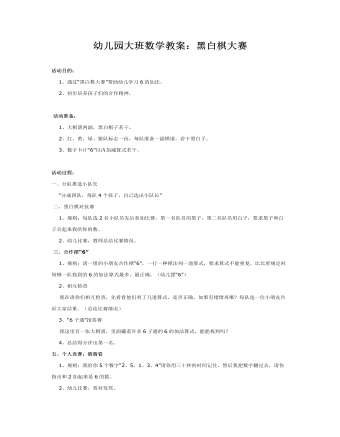
幼儿园大班数学教案:黑白棋大赛
活动准备: 1、大棋谱两副,黑白棋子若干。 2、红、黄、绿、紫队标志一份,每队准备一副棋谱,若干黑白子。 3、数字卡片“6”以内加减算式若干。 活动过程: 一、分队推选小队长 “分成四队,每队4个孩子,自己选出小队长” 二、黑白棋对抗赛 1、规则:每队选2名小队员先后参加比赛,第一名队员用黑子,第二名队员用白子,要求黑子和白子合起来我给你的数。 2、幼儿比赛,教师总结比赛情况。
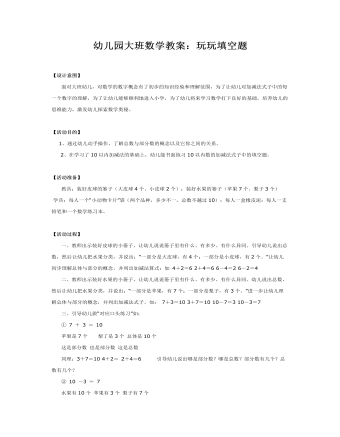
幼儿园大班数学教案:玩玩填空题
【活动目的】 1、通过幼儿动手操作,了解总数与部分数的概念以及它你之间的关系。 2、在学习了10以内加减法的基础上,幼儿能书面练习10以内数的加减法式子中的填空题。 【活动准备】 教具:装好皮球的篓子(大皮球4个、小皮球2个);装好水果的篓子(苹果7个、梨子3个) 学具:每人一个“小动物卡片”袋(两个品种,多少不一,总数不越过10);每人一盒橡皮泥;每人一支铅笔和一个数学练习本。
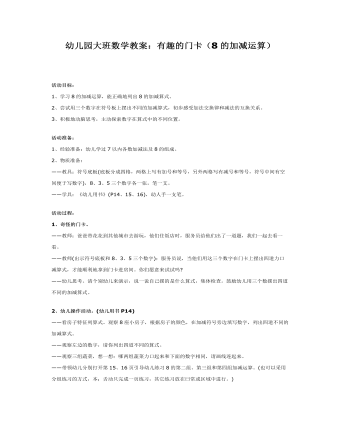
幼儿园大班数学教案:有趣的门卡
活动准备: 1、经验准备:幼儿学过7以内各数加减法及8的组成。 2、物质准备: ——教具:符号底板(底板分成四格,两格上写有加号和等号,另外两格写有减号和等号,符号中间有空间便于写数字),8、3、5三个数字各一张,笔一支。 ——学具:《幼儿用书》(P14、15、16),幼人手一支笔。活动过程: 1、奇怪的门卡。 ——教师:爸爸带花花到其他城市去游玩,他们住饭店时,服务员给他们出了一道题,我们一起去看一看。 ——教师(出示符号底板和8、3、5三个数字):服务员说,当他们用这三个数字在门卡上摆出四道力口减算式,才能顺利地拿到门卡进房间。你们愿意来试试吗? ——幼儿思考。请个别幼儿来演示,说一说自己摆的是什么算式,集体检查。鼓励幼儿用三个数摆出四道不同的加减算式。
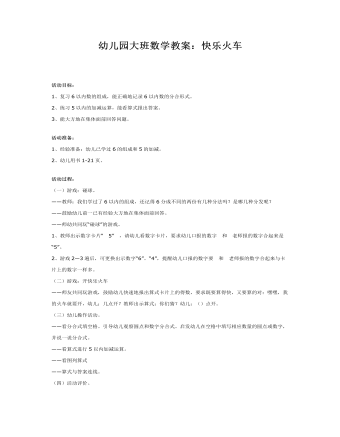
幼儿园大班数学教案:快乐火车
2、练习5以内的加减运算,能看算式报出答案。 3、能大方地在集体面前回答问题。活动准备: 1、经验准备:幼儿已学过6的组成和5的加减。 2、幼儿用书1-21页。活动过程: (一)游戏:碰球。 ——教师:我们学过了6以内的组成,还记得6分成不同的两份有几种分法吗?是哪几种分发呢? ——鼓励幼儿前一已有经验大方地在集体面前回答。 ——师幼共同玩“碰球”的游戏。 1、教师出示数字卡片“5” ,请幼儿看数字卡片,要求幼儿口报的数字 和 老师报的数字合起来是“5”。
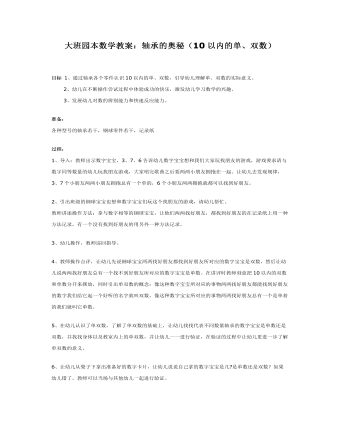
大班园本数学教案:轴承的奥秘
3、发展幼儿对数的辨别能力和快速反应能力。 准备: 各种型号的轴承若干,钢球零件若干,记录纸 过程: 1、导入:教师出示数字宝宝,3、7、6告诉幼儿数字宝宝想和我们大家玩找朋友的游戏,游戏要求请与数字同等数量的幼儿玩找朋友游戏,大家唱完歌曲之后要两两小朋友拥抱在一起。让幼儿去发现规律,3、7个小朋友两两小朋友拥抱总有一个单的,6个小朋友两两拥抱就都可以找到好朋友。 2、引出班级的钢球宝宝也想和数字宝宝们玩这个找朋友的游戏,请幼儿帮忙。 教师讲述操作方法:拿与数字相等的钢球宝宝,让他们两两找好朋友,都找到好朋友的在记录纸上用一种方法记录,有一个没有找到好朋友的用另外一种方法记录。

新人教版高中英语必修3Unit 1 Festivals and Celebrations-Listening &Speaking&Talking教学设计
The theme of this section is “Talk about festival activities and festival experiences”.Festival and holiday is a relaxing and interesting topic for students. This part talks about the topic from the daily life of students’. In the part A ---Listening and Speaking, there are three conversations among different speakers from three countries(Japan, Rio and China), where the speakers are participating in or going to participate in the festivals and celebrations. So listening for the relationship among them is a fundamental task. Actually, with the globalization and more international communication, it is normal for Chinese or foreigners to witness different festivals and celebrations in or out of China. In the Conversation 1, a foreign reporter is interviewing a Japanese young girl who just had participated in the ceremony of the Coming-of-Age Day on the street and asking her feeling about the ceremony and the afterwards activities. Conversation 2, Chinese girl Li Mei is witnessing the Rio Carnival for the first time, and her friend Carla gives her some advice on the costumes which enables her to match with the carnival to have a good time. Conversation 3, a Chinese guide is showing a group of foreign visitors around the Lantern Festival and introducing the customs of the festival to them. The three conversations have a strong vitality and insert the festival and cultural elements from different countries. So perceiving the festivals and cultures from different countries is the second task. At the same time, the scripts also insert the targeted grammar --- v-ing as attributive and predicative, which students can perceive and experience in a real context and make a road for the further study. That is the third task. In the Part B--- Listening and Talking, the theme is “Talk about festival experience”, which is the common topic in our daily conversations. During the conversation, Song Lin, a Chinese student, asked Canadian friend Max about how to spend Christmas. In the conversation, Song Lin talked about experience and the feelings during the Chinese Spring Festival, during which there are not only some enjoyable things but some unpleasant things. After the listening, perhaps students find there are some similarities between Christmas and the Chinese Spring Festival as there are some differences in the origins and celebrations. For example, people always visit friends and relatives, decorate their houses, have a big dinner together, chat and give presents to each other.

新人教版高中英语必修3Unit 1 Festivals and Celebrations-Reading for writing教学设计二
Step 3 Analyzing article structureActivity 31. Teachers raise questions to guide students to analyze the chapter structure of this diary and think about how to describe the festival experience. (1)What should be included in the opening/body/closing paragraph(s)?(2)How did the writer arrange his/her ideas?(3)What kind of interesting details did the writer describe?(4)How did the writer describe his/her feelings/emotions during the event?2. Students read and compare the three sentence patterns in activity 2. Try to rewrite the first paragraph of the diary with these three sentence patterns. After that, students exchange corrections with their partners. Such as:●This was my first time spending three days experiencing the Naadam Festival in China’s Inner Mongolia Autonomous Region and it was an enjoyable and exciting experience. ●I'll never forget my experience at the Naadam Festival because it was my first time to watch the exciting Mongolian games of horse racing, wrestling, and archery so closely. ●I'll always remember my first experience at the Naadam Festival in China’s Inner Mongolia Autonomous Region because it was so amazing to spend three days witnessing a grand Mongolian ceremony. Step 4 Accumulation of statementsActivity 41. Ask the students to read the diary again. Look for sentences that express feelings and emotions, especially those with the -ing form and the past participle. Such as:● …horse racing, wrestling, and archery, which are all so exciting to watch. ● some amazing performances● I was surprised to see…● I was a little worried about. . . ● feeling really tiredOther emotional statements:●I absolutely enjoyed the archery, too, but the horse races were my favourite part. ●I'm finally back home now, feeling really tired, but celebrating Naadam with my friend was totally worth it. ●He invited me back for the winter to stay in a traditional Mongolian tent and cat hot pot. I can’t wait!2. In addition to the use of the -ing form and the past participle, the teacher should guide the students in the appreciation of these statements, ask them to memorize them, and encourage them to use them reasonably in writing practice.

新人教版高中英语必修3Unit 1 Festivals and Celebrations-Reading for Writing教学设计一
The topic of this part is “Write about your festival experience”.During the Listening and Speaking and Talking, students are just asked to say out their festival experiences such as the Spring Festival, Mid-autumn Day, but this part students will be asked to write down their own festival experiences. During the reading part, it introduces the Naadam Festival in Inner Mongolia Autonomous Region, which can give students a good example to imitate. Students not only learn the festival, but touch and feel the Inner Mongolian’s character, the spirit and cultural atmosphere, which can help students form the cultural awareness and learn to enjoy and value the diversity of Chinese culture.Concretely, the dairy tells the experience that the author spent the Naadam Festival in Inner Mongolia Autonomous Region with his/her friend. The structure is clear. In the opening paragraph, it introduces the topic of the Naadam Festival and the whole feeling. Then it introduces the items of the festival like the ceremony, wrestling and horse racing. Finally, it summarizes this experience. Because this part is a travel journal, we must guide students pay more attention to these details: 1. use the first person. 2. use the past tense to tell the past thing and use the present or future tense to describe the scenery. 3. use the timeline to tell the development. 4. be careful for the author’s psychology, emotion and feeling, etc.1. Read quickly to get main idea; read carefully to get the detailed information about Naadam Festival.2. Learn the structure of the reading article and language.3. Write an article about a festival experience4. Learn to use the psychology, emotions and feeling in the writing.1. Write an article about a festival experience.2. Use the structure of the reading article and language.

新人教版高中英语必修3Unit 2 Morals and Virtues-Discovering Useful Structure教学设计
1. 表示时间。Hearing these stories, I’m skeptical about the place. = When I heard these stories. . . 2. 表示原因。Not knowing his address, I can’t send this book to him. = Because/Since/As I don’t know his address. . . 3. 表示结果。His father died, leaving him a lot of money. =. . . and left him a lot of money4. 表示条件。Going straight down the road, you will find the department store. = If you go straight down the road. . . 5. 表示让步。Being tired, they went on working. =Although they were tired. . . 6. 表示行为方式、伴随情况或补充说明。He lay on the grass, staring at the sky for a long time. =. . . and stared at the sky for a long time注意:非谓语动词作状语时, 如所提供的动词不能和句子中的主语保持一致, 动词-ing形式必须有自己的逻辑主语, 通常由名词或代词来担任, 这就是独立主格结构。The last bus having gone, we had to walk home. (having gone的逻辑主语是the last bus, 而不是we)Weather permitting, the football match will be played on Friday. (permitting的逻辑主语是time, 而不是the football match)Step 7 Practice1. ________(study) hard, you are sure to get first prize. 2. People use plastic in their daily life, _______(leave) large amounts of waste. 3. ________(work) hard at your lessons, you are to succeed. 4. The old man, ____________(work) abroad for twenty years, is on the way back to his motherland. 5. ______________(finish) his homework, he was playing on the playground. Answers: 1. Studying 2. leaving 3. Working 4.having worked 5. Having finishedStep 8 HomeworkFinish the homework on Page 22.

新人教版高中英语必修3Unit 2 Morals and Virtues-Listening &Speaking&Talking教学设计
Example:One day, a poor boy who was trying to pay his way through school by sending newspapers door to door found that he only had one dime(一角)left. He was so hungry that he decided to beg for a meal at the next house.However, he lost his nerve when a lovely young woman opened the door. Instead of a meal he asked for a drink of water. She thought he looked hungry so she brought him a large glass of milk. He drank it slowly, and then asked, “How much do I owe you?” “You don’t owe me anything,” she replied, “Mother has taught me never to accept pay for a kindness.” “Then I thank you from the bottom of my heart.” With these words, Howard Kelly left that house.Years later the woman became badly ill and was finally sent to the hospital in a big city. Dr. Howard Kelly, now famous, was called in. When he heard the name of the town she came from, a strange light filled his eyes. Dressed in his doctor’s clothes, Dr. Kelly went into her room and recognized her at once. From that day on, he gave special attention to her, and decided to do his best to save her life.At last the woman was saved. Dr. Kelly asked the business office to pass the final bill to him. He looked at it and then wrote something on the side. The bill was sent to the woman’s room. She was afraid to open it because she was sure that it would take the rest of her life to pay for it off. Finally she looked, and the note on the side of the bill caught her attention. She read these words: “Paid in full with a glass of milk, Dr. Howard Kelly.” Tear of joy flooded her eyes.

新人教版高中英语必修3Unit 2 Morals and Virtues-Reading and Thinking教学设计
The topic of this part is “Learn to make choices in life”.The Listening & Speaking & Talking part aims at the moral dilemmas, and this part is about making choices in life. The heroin is Lin Qiaozhi, a famous medical scientist, made a great contribution to our country’s medical care. Most importantly, her life experience can inspire our students whether in studying or the development of career. she had moral dilemmas and life choices, which are similar to the students who will step into society. Besides, Lin has quite good virtues like kindness, self-improvement, insistence, job-loving , generosity and responsibility, which is worth being learned.Concretely, this article is a biography about Lin Qiaozhi. The article tells her whole life according the timeline, among which the life choices is emphasized. For example, whether married or chased her dream, returned home or stayed abroad, family or public, her choices all reflected her faith, spirit, responsibility and devotion.1. Fast reading to get the detailed information about Lin Qiaozhi; careful reading to do the deductive information.2. Learn the reading skills--deductive judgement according the context.3. Study the structure features and language features. 4. Communicate about Lin’s life choices and reflect their own life choices.1. Learn the reading skills--deductive judgement according the context.2. Study the structure features and language features.3. Communicate about Lin’s life choices and reflect their own life choices.Step 1 Lead in---Small talkWhat are some important life choices?Importance choices: university study, jobs and marriage partners. Because they can determine our future.

新人教版高中英语必修3Unit 2 Morals and Virtues-Reading for Writing教学设计
1. 这个寓言是一个关于一位国王古寓言。 The fable is an old fable about a king.2.作者用这个故事让读者对于社区的问题负有个人责任的必要印象深刻。The author used the story to impress upon readers with the need to take personal responsibility for problems in the community.3. 这个故事十分成功的实现了它的目的。The story was quite successful in achieving its purpose.Step 7 WritingPlease write a review of the story according the outline above.The fable is an old fable about a king who thought his people are lazy, so he put a large stone in the middle of the road and hides and waited to see if anyone will try to move it.The author used this story to impress upon readers with the need to take personal responsibility for problems in the community. The story was quite successful in achieving its purpose, and I liked it because it had a clear moral.However, while the moral of the story is clear, the actions of the king seemed pointless to me, because none of the characters in the story learnt anything. For this reason, I think there are better stories that can be used to impress upon people with the need for personal responsibility.Step 8 Pair workExchange drafts with a partner. Use this checklist to help your partner revise his/her draft.1. Does the writer give a short description of the story ?2. Does the description include the most important details of the story ?3. Does the writer give his or her opinion about the character or their actions ?4. Is the review well-organised ? 5. Does the writer use the -ing form as the adverbial correctly in the writing ?6. Are there any grammar, spelling, or punctuation errors ?Step 9 HomeworkPut up your revised draft in the classroom or read it to your class.

